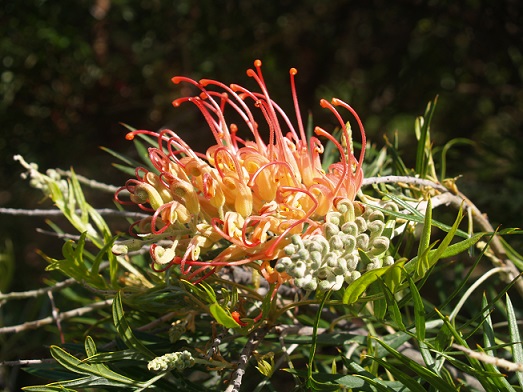Select and Cultivate Grevilleas
Grevilleas are
a wide group of plants, all but seven species coming from Australia.
They are widespread across Australia, occurring in both cool temperate,
and hot tropical climates.
Known commonly as “Spider Flowers”, the
Grevillea flower is more like a brush than a traditional flower. It has
obscure petals, but is none the less very colourful. Flower colour
varies greatly; and most hold their flowers for a long period.
Grevilleas
include both small to very large plants (from prostrate ground covers,
through small and medium shrubs up to large trees). Their hardiness is
variable according to species. The foliage is also variable ranging from
small, entire leaves to lobed or pinnate leaves. All are arranged
alternately on the stems and some have hairy under surfaces. Most have a
medium to fast growth rate.
This course provides a thorough grounding in identifying, growing and using grevilleas.

Course Content
There are 8 lessons in this course:
- Introduction.
- Review of the system of plant identification, general
characteristics of Grevilleas, information contacts (i.e. nurseries,
seed, clubs etc.)
- Culture.
- Planting, staking, mulching, watering, pest and disease, feeding, pruning, protection from wind, salt air, etc.
- Propagation.
- Methods of propagating Grevilleas. Propagation of selected varieties.
- The Most Commonly Grown Varieties.
- Other Important Groups.
- Other Grevillea Varieties.
- Making The Best Use of Grevilleas.
- In containers, in the ground, growing for profit etc. (to sell the plants) etc.
- Special Assignment. On one selected plant or group.
Each lesson culminates in an assignment which is submitted to the
school, marked by the school's tutors and returned to you with any
relevant suggestions, comments, and if necessary, extra reading.
Course Duration: 100 hours
Develop a Framework for Classifying Grevilleas
There are a variety of different ways that different “experts” have classified species of Grevillea, into groups; as a way of helping identify and understand the differences between the species. Here are some of those classification systems. You may decide to use only one of these systems, or all. Being aware of a system either way though, makes it far easier to understand and remember names and characteristics of different species.
Grouping According to Type of Flower
One way of classifying Grevilleas is according to the different types of flower heads:
- The erect cluster - flowers occur as an upright cluster at the end (or tip) of a branch or stem. The styles point in all directions - 360 degrees, like the bristles at the end of a bottlebrush e.g. Grevillea buxifolia.
- The toothbrush flower - the styles point in basically the same direction, like the bristles on a toothbrush. Flowers occur at the ends of stems or branches e.g. Grevillea hookeriana and Grevillea acanthifolia.
- The pendant cluster - where flowers occur at both growth tips (i.e. ends of foliage) and along the branches in a spider-like form (i.e. styles pointing in all directions), like the end of a rounded bottlebrush e.g. Grevillea victoriae.
- The cylinder type flower head - where flowers occur at both growth tips and around the stem. Flower heads tend towards the shape of a cylinder like the middle of a bottlebrush e.g. Grevillea banksii.
- The soft feathery flower type - these are formed in loose open terminal spikes.
McGillivray’s Groups
D.J. McGillivray published an arrangement of species involving 11 groups, in 1993 (Grevilleas – A Taxonomic Revision, by D.J. McGillivray, Melbourne University Press, 1993). This arrangement is helpful in differentiating species. However, one group is not mutually exclusive of another group.
The way to use this system is to look at a small number of key characteristics. If a plant has a smooth surface on the flower parts (no hairs) and a flattened under-surface to the leaf you can place it in group 1. In doing this, it will narrow down the number of possible species for you to consider.
If it has a smooth surface on the flower parts but curled edges underneath the leaves (partially obscuring the under-surface), this will cause it to be placed in group 3, which will in turn give you a different range of possible species to consider.
Most species that fit into one group do not appear in another group, but there can be exceptions. For example, G. rosmarinifolia appears in both group 1 and group 3 because the under-surface of the leaf may or may not be obscured.
Olde and Marriott’s Groups
In their 1994 book, Peter Olde and Neil Marriott break the genus down into 41 different groups.
These groups are differentiated on the basis of a wide range of botanical characteristics including: leaves, flowers, fruits, growth habit, and size of plant.